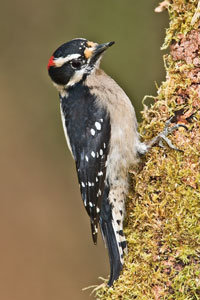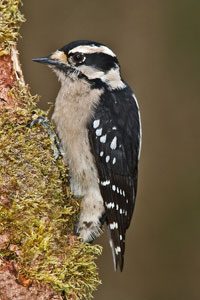

|
Downy Woodpecker (Picoides pubescens)
Description: 
What they look like: Downy woodpeckers have black and white feathers. Their stomach, chest and back are white. Their tails and wings are black. Their black wings have rows of white spots. Adult males have a red patch on the back of their heads, while females have a white stripe on the sides of their head that sometimes join together to form a ring that resembles a hallow around their black head. (photo of a male is on the left; female is on the right) If you see the Downy flying over you, you will see that underneath their wings, they have gray feathers with white spots. Their tail feathers form a V. The middle tail feathers are stiff and pointed to help the bird support itself against the trunk of the tree. All of the Downy's spots weather on top of the feathers or underneath are uniformly shaped and fit in an orderly line. 
How big they are: 5-7 inches, about the size of a small to medium bird you see in the pet store. When the Downy Woodpecker stretches its wings out, they are as long as a ruler. The bill of the Downy is small and thin, like a sliver of wood. It's only half as long as its head. A good way to tell if it's a Downy and not a Hairy Woodpecker is that the Hairy Woodpecker's bill is at least as long as its head, and thicker than the small sliver-like bill of the Downy Woodpecker. What they eat: Males and females search for food in different areas. Males prefer smaller branches and like being higher up in the trees, while females look for food in middle or lower areas of the tree. They eat bugs that live in trees. That is why woodpeckers peck holes in the trees so they can get the destructive bugs called wood boring larvae. The Downy Woodpecker is a great help to our ecosystem because they feed off of the destructive insects that hurt trees. Life Cycle: It takes less than 1 year for a Downy Woodpecker to be ready to have babies. In the spring and early summer is when they start having babies. Each egg takes 12 days to hatch and they stay with their parents for about a month. Each nest usually has 4-5 eggs.
Did You Know?
Animal silhouettes available to purchase » Photos by Natures Pics Home | About Us | How to Participate | Biodiversity Modules | Projects | Maps | News | Resources |